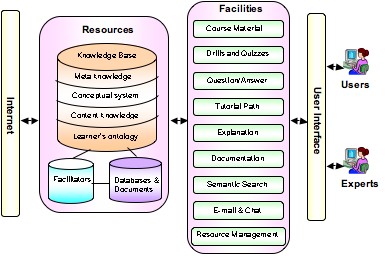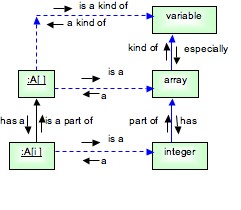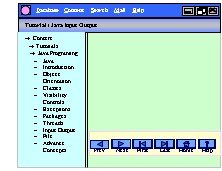EVALUATION OF IT SUPPORT: AN EXPERIMENT A survey is conducted at Department of Computer Science, Sardar Patel University, India on implemented e-Learning facilities with the following objectives:
Major activities of the surveyed department:
Infrastructure at the site: The department is located in three-storied building and has e-Learning facility supported by 10 servers and 300 workstations amongst which few are high graphics workstations. The department has two multimedia auditoriums, 8 classrooms out of which, 4 are with multimedia projectors, 2 laboratories, a workshop, a multimedia seminar hall, conference rooms, server farm, and faculty and staff offices. The software resource includes various operating systems, development environments, programming languages, tools, and departmental application along with e-content developed for various courses.
e-Learning methodology adopted: Presently, the department is utilising e-content developed for most of the courses taught. Such content shares databases and documents about learning and material through a centralised repository. 300 students of Masters of Computer Applications (MCA), 90 students of Post Graduate Diploma in Computer Applications (PGDCA), 40 students of Masters of Bioinformatics (MBI) are using the content for their studies. The databases contain different files containing information about faculty, supporting staff, infrastructure, students, and other basic resources. The documents contain lecture notes, questions, results, announcements etc.
Evaluation of e-Learning implementation: The above-discussed implemented e-Learning system is accessed by all the staff and enrolled students of the department. A survey was conducted to get the feedback of students on the implemented system. A questionnaire was prepared and distributed to 100 final year MCA students in two batches. Out of the forms received back, 94 were found to be valid. Importance level and satisfaction level of the quality parameters listed above are obtained from the users of e-Learning system implemented in the environment. The importance and satisfaction levels are scaled in Table 2.
Table 2: Importance and satisfaction level scales
Survey results: The Table 3 presents results of the survey conducted on the above listed quality parameters and degree of significance of the IT support.
Table 3: Results of survey on quality parameters and degree of significance of the IT support
From the above results, it can be clearly observed that the parameters like availability of basic resources e.g. technology, course material, question bank including documentation etc are well supported by the e-Learning methodology adopted. However, effective presentation and retrieval of information in different media help in achieving greater flexibility, which requires expertise. There is a need to customise IT support for the e-Learning methodology adopted, to continuously learn about learners’ need and selection of material in a knowledge-based fashion. Evaluations of the answers are presently restricted to objective questions only. Moreover, there is a strong need to improve user interface so as not only multimedia facility can be made available but to make user to interact in their native language. This leads to the development of a knowledge-based e-Learning model to effectively address these issues. The prototype system is developed with limited content and implemented at the site to check feasibilities of the proposed design as denoted in the Figure 1 and for further experiments. Figure 1 shows the modified structure of knowledge-based e-Learning services.
Figure 1: Knowledge-based structure of the e-learningservices
Broad e-Learning structure (Moreale & Vargas 2004) adopted experimentally as described in Figure 1 is based on custom-made knowledge manifold architecture that consists of a number of linked conceptual information landscapes (context-maps), whose concepts can be filled with content (Ambjörn at al 2005). The system considers databases and necessary documents through knowledge base ontologies consisting of meta-knowledge, conceptual system, content-knowledge, vocabulary, and learners’ knowledge. According to Stojanovic (2004) and Noy & Klein (2004), ontology is required to formally describe shared meaning of the used vocabulary (set of symbols). In fact, ontology constrains the set of possible mapping between symbols and their meanings (Stojanovic 2004; Noy & Klein 2004). The ontology provides the strategy for authorisation, content management, and information retrieval. An Ontology Service holds one or several ontologies and can be asked to return a whole ontology, or part of it (e.g. a sub-graph selected via some filter criterion), or can answer queries of the kind “give me all sub-concepts of concept C”, “which properties are defined for concept C”, “who authored concept C”, etc. (Dolog at al 2004). Knowledge base of the system also considers metadata as the total sum of what one can say about any information object at any level of aggregation, considering that an information object is anything that can be addressed and manipulated by a human or a system as a discrete entity (Tony, Anne & Mary 2005). This property of metadata helps in enabling effective search of resources across multiple repositories, since dealing with descriptive surrogates of resources is easier than dealing with the resources themselves (Alsultanny 2006). To meet the learner’s objective of utilising the system, system should ‘know’ its users. For this purpose, the target learner’s ontologies are also stored in a knowledge base. Similarly, domain knowledge is also an important requirement for the system. The conceptual system provides the framework of the system. Using the knowledge base and existing database, the system offers facilities like effective course material presentation, quizzes, drills and questions/answers, documentation provision, etc. through facilitator programmes. Moreover, the system also supports semantic search, explanation, evaluation, and knowledge management through well-designed user interface. Teachers may use the e-content facility to demonstrate course topics in classrooms, which makes their teaching more effective. The system has facility of notice board, chat and mail through internet connection. Figure 2A shows how the domain knowledge representation about a topic can be represented internally. Here, an example of integer array is given. Arrays are the basic unit of any programming language encompassing same size and same type of elements under a common name. Figure 2A explains that array A is a kind of variable of integer type represented as A[i], where I represents the index of referred variable within the group. This is semantic representation of topic ‘arrays of programming language’ in knowledge structure. Such semantic representation have their well-defined representation criteria and reasoning schemes, so further management and explanation becomes easy. Similarly, all the topics of the tutorial can be represented in suitable knowledge representation schemes to access the system in knowledge-based way. Figure 2B and 2C presents sample screens presented to user for the programming language tutorial.
Figure 2B: Screen showing learning facility to a student
Figure 2C: Screen showing programming language tutorial
The infrastructure can be linked directly with the facilities like internet, other university programmes through video conferencing using EDUSET (educational Satellite), radio station/television programmes etc. However, for privacy and security reasons, presently the system is not linked with such facilities, but these facilities are separately made available through different server. A similar survey is conducted for the modified e-Learning with the same parameter list so as to compare the modified e-Learning approach with the previous one. Following graph presents the comparison results between both the approaches.
Table 4: Results of survey the modified e-Learning
Figure 3: Comparison results of the approaches
CONCLUSION IT is one of the effective tools to accelerate the learning process in highly customised manner. The two surveys conducted here indicate that the base technology and infrastructure to provide effective functionality are critical for successful implementation of the adopted e-Learning model. Various institutions maintain a variety of training resources to ensure a basic level of proficiency. The result of the surveys highlights the need of knowledge-based approach to achieve the advantages like effective retrieval and presentation, identifying users need, evaluation of users responses, and explanation and justification of the systems own decisions made to achieve high degree of quality. Institutions must be aware of evolving technical skill levels and adapt their resources accordingly to handle the shifting need for advanced technical and pedagogical training to ensure proper utilisation of e-Learning techniques. In addition to this, institutions offering the technology must continuously balance the growth in number of e-Learning courses with the changing dynamics of support structure. Moreover, the development in e-Learning has to be oriented at the learner’s needs and situation. The quality and orientation towards learners needs are critical factors to determine the effectiveness of the system. Successful IT implementation should address (i) general technical support; (ii) expanded information accessibility through resources; and (iii) mechanism system, to utilise the technical support and other resources. The quality factors denoted in this paper are also helpful in providing quality measures for e-Learning systems. This also helps in determining the impact of a given quality parameter for e-Learning systems and hence provides guidelines for successful development.
REFERENCES Alsultanny, Y. (2006), “e-Learning system overview based on semantic web”, The Electronic Journal of e-Learning, vol.4, no.2, pp.111-118. Ambjörn, N., Mikael, N., Matthias, P. & Fredrik, P. (2005), “Contributions to a public e-learning platform: infrastructure; architecture; frameworks; tools”, International Journal of Learning Technology, vol. 1, no.3, pp.352-381. Dolog, P., Henze, N., Nejdl, W. & Sintek, M. (2004), “Personalisation in distributed eLearning environments”, Proceedings of WWW2004 - The Thirteenth International World Wide Web Conference, New York, USA. Ehlers, U. (2004), “Quality in e-learning from a learner's perspective”, European Journal of Open Distance and E-Learning. May. Retrieved on 2 May 2007 from http://www.eurodl.org/materials/contrib/2004/Online_Master_COPs.html Gotschall, M. (2000), “E-learning strategies for executive education and corporate training”, Fortune, vol. 141, no.10, pp.S5-S59. Hall, B. (2000), “How to embark on your e-Learning adventure: Making sense of the environment”, e-Learning, January-March. Kanendran, T.A., Johnny, S. & Durga, B.V. (2004), “Technical report: Issues and strategies of e-Learning”, Sunway College Journal, vol.1, pp.99-107. Moreale, E. & Vargas, M. (2004), “Semantic services in e-Learning: an argumentation case study”, Educational Technology & Society, vol.7, no.4, pp.112-128. Noy, N. & Klein, M. (2004), “Ontology Evolution: Not the same as schema evolution”, Knowledge and Information Systems, vol.6, no.4, pp.428-440. Shreiber, D.A. & Berge, Z.L. (1998), “Distance training: How innovative organisations are using technology to maximise learning and business objectives”, Jossey-Bass, San Francisco, CA. Stojanovic, L. (2004), “Methods and tools for ontology evolution”, PhD thesis, Universitat Karlsruhe. Tony, G., Anne, J.G., & Mary, S.W. (2005), “Introduction to metadata: Pathways to digital information”, Online Edition, Version 2.1, Retrieved 9 September 2007 from http://www.getty.edu/research/institute/standards/intrometadata/ Unwin, D. (2003), “Information support for e-Learning: principles and practice”, UK eUniversities Worldwide Summer. Urdan, T.A. & Weggen, C.C. (2000), “Corporate e-Learning: Exploring a new frontier”, WR Hambrecht + Co. Retrieved 3 August 2001 from http://www.wrhambrecht.com/research/coverage/elearning/ir/ir_explore.html Zahm, S. (2000), “No question about it - e-Learning is here to stay: A quick history of the e-Learning evolution”, e-Learning, vol.1, no.1, pp.44-47.
Copyright for articles published in this journal is retained by the authors, with first publication rights granted to the journal. By virtue of their appearance in this open access journal, articles are free to use, with proper attribution, in educational and other non-commercial settings.Original article at: http://ijedict.dec.uwi.edu//viewarticle.php?id=435&layout=html
|




